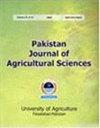Controlled drainage, to cope with the adverse impacts of climate change on paddy field’s hydrology: a simulation study using the drainmod model, Kunshan, China
IF 0.6
4区 农林科学
Q3 AGRICULTURE, MULTIDISCIPLINARY
引用次数: 2
Abstract
A study was carried out to assess the DRAINMOD model in predicting the role of Controlled Drainage strategies and Drain Spacing scenarios in the paddy field. The DRAINMOD model was simulated for the current (2018), Near Future 2021 to 2060 and Far Future 2061 to 2099 in the Kunshan region, China. Potential Evapotranspiration was estimated by the Thornthwaite method. The model performed good agreement in predicting paddy’s water balance for the period of 2017-18. Also, Projections of the future climate in the Kunshan region, showed that there will be a decrease in the annual precipitation during rice-growing seasons for both Near Future (2021-2060) and Far Future (2061-2099). The DRAINMOD model was utilized to evaluate the impact of such a future decrease in precipitation on ground Water Tables Depth. Compared to the rice-growing season of 2018, DRAINMOD simulations showed that future Water Table Depths will drop by 38% to 40% for both the Near Future and Far Future under the Representative Concentration Pathway (RCP) 4.5 and RCP 8.5. Such future remarkable drop in Water Table Depths may affect rice yield in the study region. The future water balance in the study area was re-simulated after replacing conventional drainage with Controlled Drainage and an increase in the drain spacing. Simulations revealed that practicing Controlled Drainage and an increase in drain spacing mitigated the future drop in Water Table Depths, thus ensuring better soil moisture conditions for rice. Therefore, Controlled Drainage approaches have the potential to cope with the adverse impacts of climate changes in the paddy fields.控制排水,应对气候变化对水田水文的不利影响——基于排水模型的模拟研究,昆山
进行了一项研究,以评估DRAINMOD模型在预测稻田中控制排水策略和排水沟间距情景中的作用。DRAINMOD模型在中国昆山地区模拟了当前(2018)、2021年至2060年的近期和2061年至2099年的远期。潜在蒸散量采用Thornthwaite法估算。该模型在预测2017-18年水稻水分平衡方面表现出良好的一致性。此外,对昆山地区未来气候的预测显示,近期(2021-2060)和远期(2061-2099)水稻生长季节的年降水量都将减少。DRAINMOD模型用于评估未来降水量减少对地下水位深度的影响。与2018年水稻生长季节相比,DRAINMOD模拟显示,在代表性浓度路径(RCP)4.5和RCP 8.5下,近期和远期的未来地下水位深度将下降38%至40%。未来地下水位深度的显著下降可能会影响研究区域的水稻产量。在用控制排水取代传统排水并增加排水间距后,重新模拟了研究区域未来的水平衡。模拟表明,实行控制排水和增加排水间距可以缓解未来地下水位深度的下降,从而确保水稻的土壤水分条件更好。因此,控制排水方法有可能应对气候变化对稻田的不利影响。
本文章由计算机程序翻译,如有差异,请以英文原文为准。
求助全文
约1分钟内获得全文
求助全文
来源期刊

Pakistan Journal of Agricultural Sciences
AGRICULTURE, MULTIDISCIPLINARY-
CiteScore
1.80
自引率
25.00%
发文量
18
审稿时长
6-12 weeks
期刊介绍:
Pakistan Journal of Agricultural Sciences is published in English four times a year. The journal publishes original articles on all aspects of agriculture and allied fields.
 求助内容:
求助内容: 应助结果提醒方式:
应助结果提醒方式:


